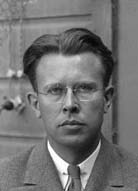 Ernest Orlando Lawrence (August 8, 1901 – August 27, 1958) was an American physicist and Nobel Laureate, known for his invention, utilization, and improvement of the cyclotron atom-smasher beginning in 1929, based on his studies of the works of Rolf Widerøe, and his later work in uranium-isotope separation for the Manhattan Project. Lawrence had a long career at the University of California, where he became a Professor of Physics. In 1939, Lawrence was awarded the Nobel Prize in Physics for his work in inventing the cyclotron and developing its applications. Chemical element number 103 is named "lawrencium" in Lawrence's honor. He was also the first recipient of the Sylvanus Thayer Award. His brother John H. Lawrence was known for pioneering in the field of nuclear medicine.
Ernest Orlando Lawrence (August 8, 1901 – August 27, 1958) was an American physicist and Nobel Laureate, known for his invention, utilization, and improvement of the cyclotron atom-smasher beginning in 1929, based on his studies of the works of Rolf Widerøe, and his later work in uranium-isotope separation for the Manhattan Project. Lawrence had a long career at the University of California, where he became a Professor of Physics. In 1939, Lawrence was awarded the Nobel Prize in Physics for his work in inventing the cyclotron and developing its applications. Chemical element number 103 is named "lawrencium" in Lawrence's honor. He was also the first recipient of the Sylvanus Thayer Award. His brother John H. Lawrence was known for pioneering in the field of nuclear medicine.
Lawrence attended completed his bachelor's degree at the University of South Dakota in 1922. He earned his master's degree in physics from the University of Minnesota in 1923. Next, Lawrence spent a year at the University of Chicago, and then he moved on to Yale University, where he completed his Ph.D. degree in physics in 1925. In 1928, Lawrence was hired as an Associate Professor of Physics at the University of California, and two years later he became a full Professor, becoming the youngest Professor at the University of California. There, he was called the "Atom Smasher", and the man who "held the key" to atomic energy.
During World War II, Lawrence eagerly helped to ramp up the American investigation of the possibility of a weapon utilizing nuclear fission. His Rad Lab became one of the major centers for wartime nuclear research, and it was Lawrence who first introduced J. Robert Oppenheimer into what would soon become the Manhattan Project. An early champion of the electromagnetic separation method to enrich uranium and increase its percentage of fissile U-235, Lawrence manufactured his magnetic calutrons — specialized forms of mass spectrometers — for the massive isotope separation plants in Oak Ridge, Tennessee.
After the war, Lawrence campaigned extensively for government sponsorship of large scientific programs. Lawrence was a forceful advocate of "Big Science" with its requirements for big machines and big money.
For his service to his country, Lawrence received the Enrico Fermi Award from the U.S. Atomic Energy Commission in 1957, and was the first recipient of the prestigious Sylvanus Thayer Award by the United States Military Academy in 1958.